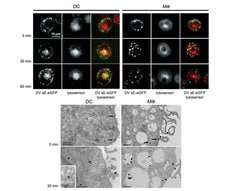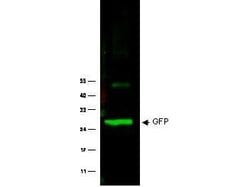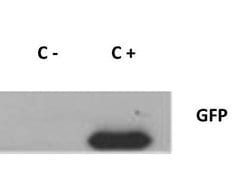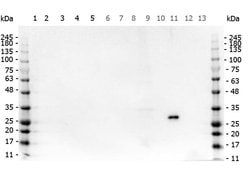Learn More
GFP Polyclonal Antibody, Rockland™


Rabbit Polyclonal Antibody
$178.35 - $1089.32
Specifications
| Antigen | GFP |
|---|---|
| Concentration | 0.99 mg/mL |
| Applications | ELISA, Immunofluorescence, Immunohistochemistry, Immunoprecipitation, Western Blot |
| Classification | Polyclonal |
| Conjugate | Unconjugated |
| Catalog Number | Mfr. No. | Quantity | Price | Quantity & Availability | |||||
|---|---|---|---|---|---|---|---|---|---|
| Catalog Number | Mfr. No. | Quantity | Price | Quantity & Availability | |||||
50-199-1682
 
|
Rockland Immunochemicals
600401215 |
100 μg |
Each for $477.24
|
|
|||||
50-105-7817
 
|
Rockland Immunochemicals
600401215S |
25 μL |
Each for $178.35
|
|
|||||
50-194-3835
 
|
Rockland Immunochemicals
600401215L |
1 mg |
Each for $1,089.32
|
|
|||||
Description
Store vial at -20°C prior to opening. Aliquot contents and freeze at -20°C or below for extended storage. Avoid cycles of freezing and thawing. Centrifuge product if not completely clear after standing at room temperature. This product is stable for several weeks at 4°C as an undiluted liquid. Dilute only prior to immediate use. Assay by immunoelectrophoresis resulted in a single precipitin arc against anti-Rabbit Serum and purified and partially purified Green Fluorescent Protein (Aequorea victoria). No reaction was observed against Human, Mouse or Rat serum proteins.
The jellyfish Aequorea victoria contains green fluorescent protein (GFP Tag) that emits light in the bioluminescence reaction of the animal. GFP has been used widely as a reporter protein for gene expression in eukaryotic and prokaryotic organisms, and as a protein tag in cell culture and in multicellular organisms. As a fusion tag, GFP can be used to localize proteins, to study their movement or to research the dynamics of the subcellular compartments where these proteins are targeted. GFP technology has revealed considerable new insights in the physiological activities of living cells. GFP is a 27 kDa monomeric protein, which autocatalytically forms a fluorescent pigment. The wild type protein absorbs blue light (maximally at 395nm) and emits green light (peak emission 508nm) in the absence of additional proteins, substrates, or co-factors. GFP fluorescence is stable, species independent and is suitable for a variety of applications. GFP has been used extensively as a fluorescent tag to monitor gene expressin and protein localization. Moreover, other applications for GFP include its use in assessing protein protein interactions in the yeast two hybrid system, and in measuring distances between proteins in fluorescence energy transfer (FRET) experiments.Specifications
| GFP | |
| ELISA, Immunofluorescence, Immunohistochemistry, Immunoprecipitation, Western Blot | |
| Unconjugated | |
| Rabbit | |
| 0.02M potassium phosphate with 0.15M NaCl and 0.01% sodium azide; pH 7.2 | |
| Primary | |
| Antibody |
| 0.99 mg/mL | |
| Polyclonal | |
| Liquid | |
| RUO | |
| GFP; GFP tag; GFP2; Turbo eGFP | |
| -20°C, Avoid Freeze/Thaw Cycles |
The Fisher Scientific Encompass Program offers items which are not part of our distribution portfolio. These products typically do not have pictures or detailed descriptions. However, we are committed to improving your shopping experience. Please use the form below to provide feedback related to the content on this product.



